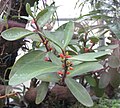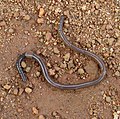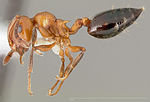Myrmecophytes (/mərˈmɛkəfaɪt/; literally "ant-plant") are plants that live in a mutualistic association with a colony of ants. There are over 100 different...
19 KB (1,979 words) - 14:36, 28 July 2024
the African mahogany, afzelia, lenke, lengue, apa, or doussi, is a Myrmecophyte tree species in the family Fabaceae. It occurs in Benin, Burkina Faso...
5 KB (488 words) - 23:51, 30 November 2023
plants and trees, such as thorns or branches; these hosts are known as myrmecophytes. Tetraponera species are closely related to the New World genus of ants...
13 KB (1,210 words) - 03:21, 14 January 2023
Hydnophytum formicarum (category Myrmecophytes)
Southeast Asia and is considered critically endangered in Singapore. It is a myrmecophyte as ants live in its tuber, also known as a caudex, and pollinate its...
11 KB (1,431 words) - 23:01, 8 May 2024
gut; others have hooks that enable them to attach to a mammal's fur. Myrmecophytes are plants that have coevolved with ants. The plant provides a home...
95 KB (8,045 words) - 11:03, 11 August 2024
Pseudomyrmex spinicola is a species of red myrmecophyte-inhabiting neotropical ants which are found only in Nicaragua and Costa Rica. They live in the...
4 KB (477 words) - 00:52, 4 August 2024
rhizome forms hollow spaces that act shelter for ants, making this a myrmecophyte, similar to others in this genus. "Lecanopteris carnosa". Plants of the...
2 KB (145 words) - 01:37, 7 January 2024
mutualistic relationship with stingless shelter ants, which makes it a myrmecophyte. The ant species associated with L. sinuosa belong within the genera...
4 KB (451 words) - 02:18, 27 July 2024
M. (May 2006). "Co-existence of ants and an arboreal earthworm in a myrmecophyte of the Indian Western Ghats: anti-predation effect of the earthworm mucus"...
62 KB (7,620 words) - 23:35, 10 July 2024
Duroia hirsuta is a myrmecophyte tree species from the Amazon Forest. It is one of some 37 species of Duroia, which are shrubs or canopy trees in the family...
6 KB (688 words) - 00:41, 18 January 2024
species of epiphytic fern, native to tropical South America. It is a myrmecophyte, producing domatia in its rhizome which ants live. "Microgramma megalophylla...
1 KB (79 words) - 01:58, 3 May 2024
Borges (2006). "Co-existence of ants and an arboreal earthworm in a myrmecophyte of the Indian Western Ghats: anti-predation effect of the earthworm mucus"...
2 KB (196 words) - 16:53, 20 April 2023
Vachellia cornigera (category Myrmecophytes)
known as bullhorn acacia (family Fabaceae), is a swollen-thorn tree and Myrmecophyte native to Mexico and Central America. The common name of "bullhorn" refers...
14 KB (1,770 words) - 22:56, 8 May 2024
pollinating flowers. For example, the orchid Leporella fimbriata is a myrmecophyte which can only be pollinated by the winged male ant M. urens. Pollination...
138 KB (14,255 words) - 06:46, 5 July 2024
Triplaris americana (category Myrmecophytes)
range, including Hawaii and southern Africa. This species of tree is a myrmecophyte and it has a mutualistic relationship with ants, including Pseudomyrmex...
4 KB (428 words) - 21:29, 28 December 2023
utilise rhizobia (nitrogen fixing bacteria) in their root nodules. Myrmecophytes, including Myrmecodia spp. and Hydnophytum spp., are tree species that...
7 KB (741 words) - 07:01, 30 March 2024
including the Leguminosae, Euphorbiaceae, and Orchidaceae. In general, myrmecophytes (or ant plants) usually provide some form of shelter and food in exchange...
33 KB (4,315 words) - 11:11, 17 February 2024
Urtica (80 species), and Cecropia (75 species). Cecropia contains many myrmecophytes. Urticaceae species can be found worldwide, apart from the polar regions...
23 KB (1,943 words) - 19:16, 14 April 2024
8 in) in diameter. This rhizome forms a shelter for ants, making this a myrmecophyte, though unlike others of its genus the rhizome is flattened and doesn't...
2 KB (193 words) - 01:36, 7 January 2024
its host myrmecophyte Barteria fistulosa (Passifloraceae) through aggressiveness and predation: HOW A PLANT ANT PROTECTS ITS HOST MYRMECOPHYTE". Biological...
7 KB (756 words) - 16:49, 23 July 2024
insects thrown out by the ants are absorbed by the lenticular warts in myrmecophytes like Hydnophytum and Myrmecodia. Myrmecodia uses its lenticular warts...
2 KB (179 words) - 22:14, 20 August 2023
food, but many herbivores avoid these plants; most Cecropia spp. are myrmecophytes, housing dolichoderine ants of the genus Azteca, which vigorously defend...
25 KB (3,341 words) - 12:14, 7 January 2024
Piper cenocladum (category Myrmecophytes)
a member of the same genus as kava, betel, and black pepper. It is a myrmecophyte, a plant that lives in ecological mutualism with ants. This plant and...
2 KB (282 words) - 22:57, 8 May 2024
Myrmecodia tuberosa (category Myrmecophytes)
Myrmecodia tuberosa young plant Janzen, Daniel H. (1974). "Epiphytic Myrmecophytes in Sarawak: Mutualism Through the Feeding of Plants by Ants". Biotropica...
1 KB (95 words) - 22:57, 8 May 2024
phosphatase into its tanks. Another species, Brocchinia acuminata, is ant-fed myrmecophyte, apparently depending in part on nutrients and dead nestmates dropping...
10 KB (1,173 words) - 11:46, 15 June 2023
Dischidia (category Myrmecophytes)
Dischidia is a genus of plants in the “dog-bane” family Apocynaceae, collectively known as the “milkweeds” (true perennial milkweeds in the Apocynaceae...
12 KB (1,045 words) - 21:29, 12 January 2024
southeastern Nigeria. It is divided into four sub-species, of which three are myrmecophytes. Leonardoxa africana subsp. africana Leonardoxa africana subsp. gracilicaulis...
4 KB (401 words) - 06:18, 4 September 2023
assassin among predators: the relationship between plant-ants, their host myrmecophytes and the Reduviidae Zelus annulosus". PLoS ONE. 5 (10): e13110. Bibcode:2010PLoSO...
2 KB (164 words) - 17:29, 20 November 2021
rainforest that resides in the undergrowth. It is also an example of a myrmecophyte, because it contains ant-domatia, leaf pouches and hollow chambers where...
19 KB (2,562 words) - 14:21, 26 March 2024
Itioka. "Species-specific Leaf Volatile Compounds of Obligate Macaranga Myrmecophytes and Host-specific Aggressiveness of Symbiotic Crematogaster Ants." Journal...
47 KB (3,642 words) - 06:27, 24 February 2024

























